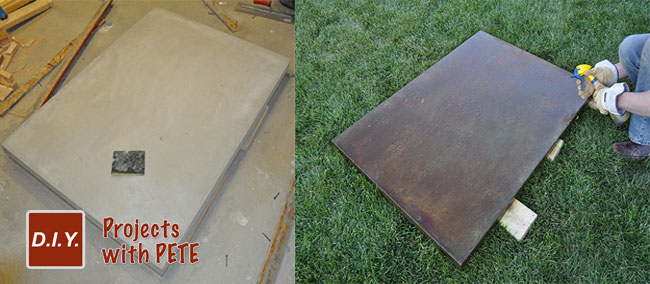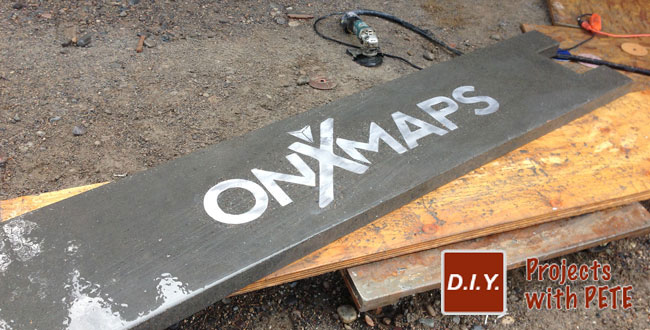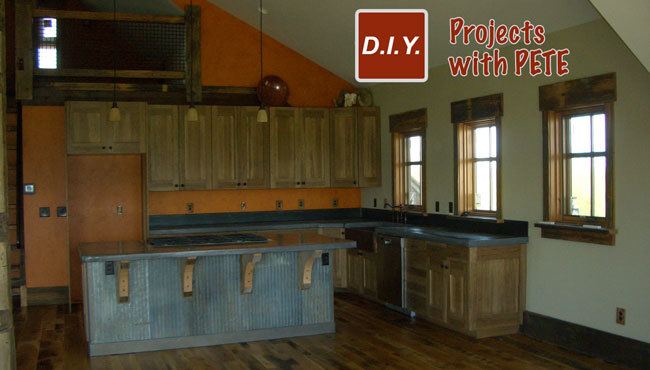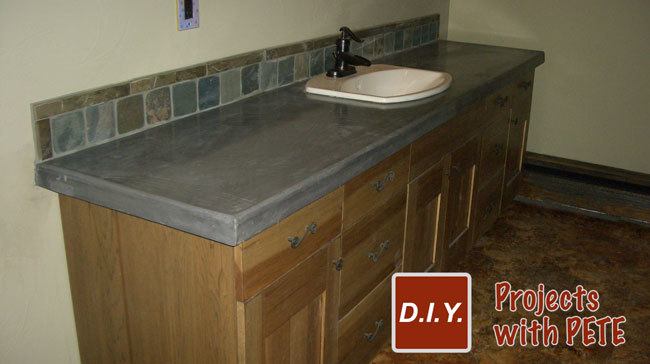Concrete tables are a great DIY project for anyone. I remember back to the first concrete table I ever made. That was in 2007 after watching an episode about concrete counters on the DIY Network. Since then, I've built a number of tables and counters. I've also helped thousands of people make their own tables through my tutorials and videos online, which is very rewarding.
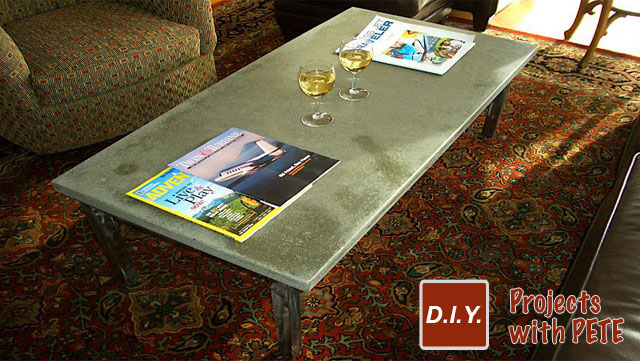 You will learn a lot during each concrete table you build. The first one will have room for improvement, and each table will be a little better than the last. It's a process of learning, trying, and simply figuring things out. Concrete is not rocket science, but there are definitely some tricks to the trade. Practice will lead you toward perfection.
You will learn a lot during each concrete table you build. The first one will have room for improvement, and each table will be a little better than the last. It's a process of learning, trying, and simply figuring things out. Concrete is not rocket science, but there are definitely some tricks to the trade. Practice will lead you toward perfection.
In this post I am going to go over some of the finishing basics about concrete tables, and share photos to inspire you to try making your own!
Concrete Table Methods
There are essentially 2 techniques for creating concrete tables. They are pour in place or pre-cast.
Pour in Place / Right side up – Pour in Place tables are cast right side up. A mold is built, the concrete is poured, and then you must create a very flat and finished surface using a trowel. Troweling is an art and takes practice. However; once you get the trowel finish down you'll be able to get a very natural finish with variations and neat trowel marks. To get the perfect finish, you'll need to watch the concrete like a hawk after you pour it and tend to it every half hour until it is troweled to your liking.
Advantages:
- Once you are done troweling simply do a light sanding and then seal
- No air holes to fill
- Complete entire process in 1 or 2 days
- Natural Finish
- No moving is needed
Disadvantages:
- Takes practice to make trowel well
- Must tend to counter for at least a few hours after pouring
- Need to baby it and watch like a hawk
- Can be messy – will need to protect area you are working in
Pre-cast – Pre-cast concrete tables and counters are what I'd recommend for someone just getting started because you do not need to have the troweling experience. It is also the way to go if you want to polish it and have a perfectly flat surface or if you want to embed glass or any object in the surface.
Advantages:
- Easily get a flat surface
- Embed objects in the concrete
- Great for Polishing
- Once you pour and level, you are done for the day
- Control the environment (create in a shop or garage offsite)
- Great technique for building tables
Disadvantages
- Polishing and filling in air holes is a tedious and somewhat dirty job
- Need to transport and carry
Here is a video I created showing the process for making a pre-cast table. Check out the full concrete table post with detailed instructions as well!
Finish Techniques
There are a number of ways to finish a table and I will touch on the most commonly used methods.
Polished Finish: Polishing a concrete table will give you a beautiful finish. Using a wet polisher, you have the ability to expose the aggregate (rock and sand) in the concrete and polish it perfectly flat with the surface of the table. The more you grind, the more rocks and aggregate that will be exposed. Wet polishers use concrete polishing pads that work in the same manner as sandpaper. The lower the grit, the faster you'll expose aggregate. Starting with a 50 grit pad will grind quickly. You will then work up to 100 grit, followed by 200 and then up to 400. Do not skip a pad, otherwise you will have swirl marks in the finished piece. Pads below 400 grit are referred to as grinding pads. Once you get up to 800 you are polishing and not really grinding into the concrete any more. (Notice in the example below I polished more in certain places to expose aggregate in random patterns.)
Vein Finish: To get the vein finish you will need to have a wet polisher. The vein technique can give you a marble look with the concrete. To create a vein finish, you'll pack the mold differently and try to create voids in the concrete. You will use a dryer mix, ball up the concrete, and then pack each handful next to each other randomly. Voids will be created between the balled up and squashed concrete. (Example below – also look at the Salmon colored Grill counter in the ideas section of the post)
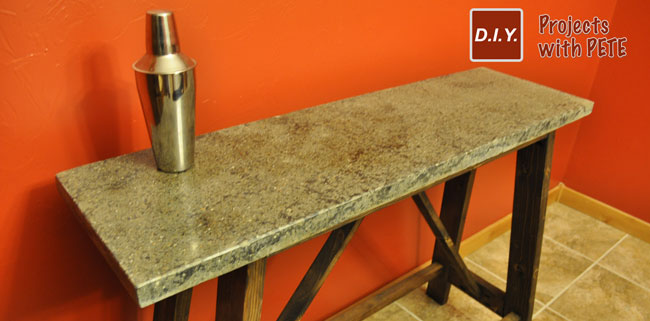 Sanded Finish: In the video above I use an orbital sander to finish the piece. This method works well and is great if you don't have a wet polisher. However, you don't expose aggregate with this method because the sand paper will not cut through rock well. With the sanding method you'll get a real creamy concrete finish like below (as shown in the video tutorial).
Sanded Finish: In the video above I use an orbital sander to finish the piece. This method works well and is great if you don't have a wet polisher. However, you don't expose aggregate with this method because the sand paper will not cut through rock well. With the sanding method you'll get a real creamy concrete finish like below (as shown in the video tutorial).

Hard Trowel Finish: A very natural looking finish. You get neat variation and use a trowel to accomplish this finish. Below is a photo of a table I made with an old world type look. This is 1.5″ thick with English Red and Cola acid stains.
Here is a video from the Concrete Network showing an overview of a few of the techniques.
Color Techniques
You have a few options when it comes to coloring your concrete table.
1. Add color to concrete mix – You can purchase liquid or solid pigment that can be added while mixing concrete. Quikrete offers about 5 different colors that can be found at Home Depot. More options can be found at your local concrete supplier or on Amazon.com.
Acid Stain – Acid stains are by far my favorite way to color tables. The acid reacts with the limestone in the concrete and gives it variations in color. These stains penetrate about 1/8 of an inch into the concrete. Many floors at coffee shops and restaurants have been acid stained. The stain can be sprayed or brushed on after polishing/sanding/troweling.
Here is a photo showing the acid stain application. ( Before and After )
Dyes and Acrylic Stains – Dyes and acrylic stains are applied after polishing/sanding/troweling. Many colors are available.
Sealer
A variety of sealers are used for tables and counters. For tables, I typically use an acrylic concrete sealer available at Home Depot. After sealing, I wax with either beeswax or Johnson's Paste Wax
Concrete
There are a number of mixes I like to use for concrete furniture. Sometime's I'll make my own mix, but for the majority of my projects I use the Quikrete 5000 or Quikrete non-shrink precision grout. I've been making tables and counters with Quikrete since 2006 (7 years) and have not had 1 crack. Quikrete is affordable, easy to work with, and bomb proof. Try out other mixes and find what works well for you. Buddy Rhodes has his own mix and it is fun to work with, but it is $45 / bag. Quikrete is $5.00 per bag.
Examples of a few Concrete Pieces I've Made
The concrete top below is 2 1/4 thick and is stained with Green Acid Stain from Kemiko. I made the base out of lodgepole pine using my 1 1/2 inch tenon cutter.
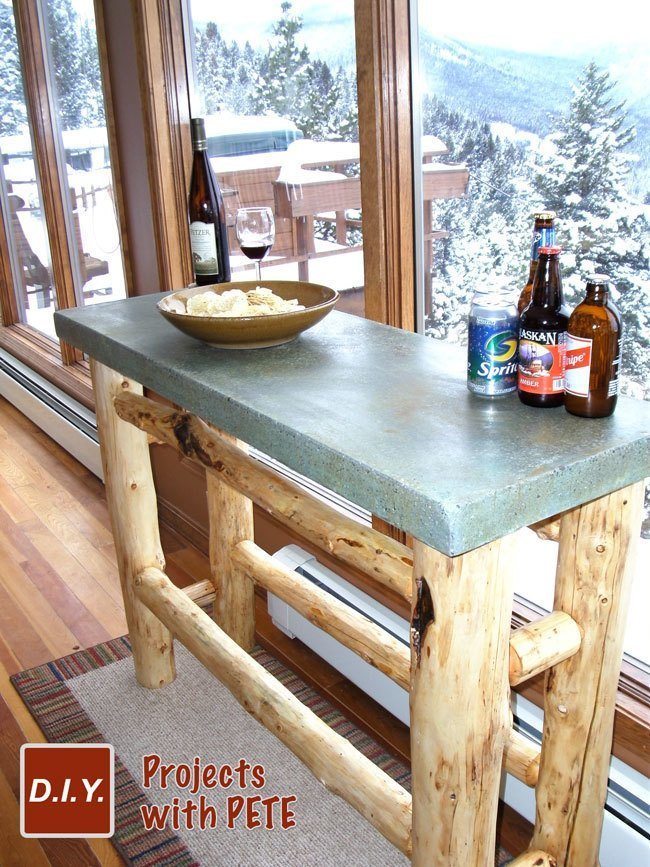 Here is a polished concrete table I made. The base was welded out of 1 1/4 inch steel tubing using my Lincoln Flux Core 110 Welder. No color was added, and very little aggregate was exposed.
Here is a polished concrete table I made. The base was welded out of 1 1/4 inch steel tubing using my Lincoln Flux Core 110 Welder. No color was added, and very little aggregate was exposed.
 Below is a counter I created using the veined technique. Look closely and you will see the color variations. I used the Buddy Rhodes concrete mix for this project and used a slightly different color to fill the the veins.
Below is a counter I created using the veined technique. Look closely and you will see the color variations. I used the Buddy Rhodes concrete mix for this project and used a slightly different color to fill the the veins.

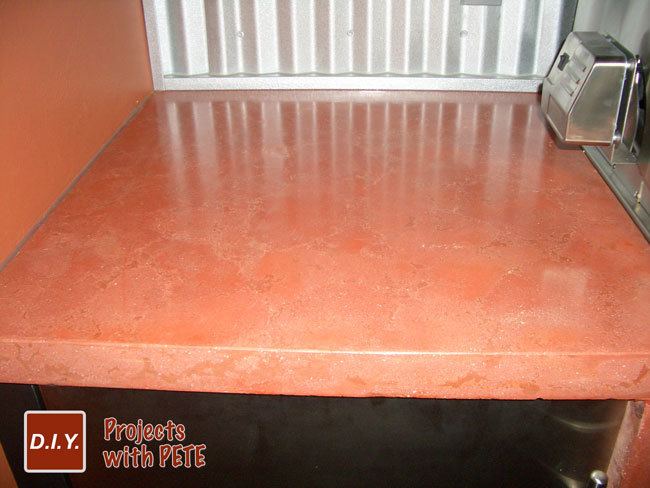 Here is a 2.5 inch thick concrete hearth I created using the Quikcrete 5000 mix. It was acid stained with Cola, English Red, and Umber from Kemiko.
Here is a 2.5 inch thick concrete hearth I created using the Quikcrete 5000 mix. It was acid stained with Cola, English Red, and Umber from Kemiko.
 Polished top with plasma cut metal logo. You can learn more about this project by going to the onXmaps project post.
Polished top with plasma cut metal logo. You can learn more about this project by going to the onXmaps project post.
 This is a 2 inch thick polished concrete top with steel base. The steel base has a maroon and brown patina.
This is a 2 inch thick polished concrete top with steel base. The steel base has a maroon and brown patina.
 Below are kitchen counters with a real natural and rustic look. These were mixed to a charcoal slate color and poured in place.
Below are kitchen counters with a real natural and rustic look. These were mixed to a charcoal slate color and poured in place.
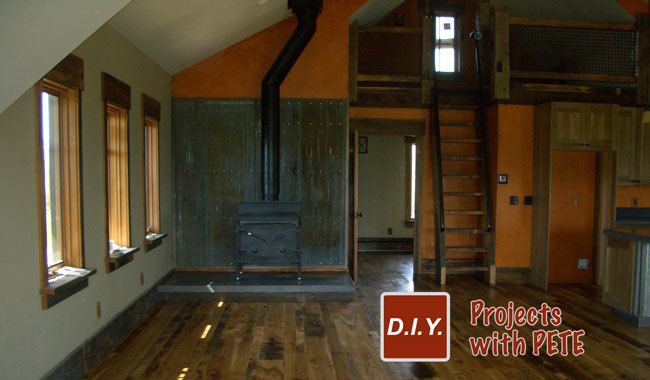 Rustic concrete table with cola acid stain
Rustic concrete table with cola acid stain
 Polished concrete counters I made for my older brother in Minneapolis
Polished concrete counters I made for my older brother in Minneapolis

My first experimentations with fiber optics in concrete
 My first fiber optic logo in concrete. GO MONTANA STATE BOBCATS!
My first fiber optic logo in concrete. GO MONTANA STATE BOBCATS!
 Embedding Glass and Stones in concrete counters and tables
Embedding Glass and Stones in concrete counters and tables
 Up close photo of vanity after polishing
Up close photo of vanity after polishing

 I hope the information and examples in this post will spark ideas for your next concrete project! Please comment below to contact me or ask questions. Please pin photos of the projects you like by hovering over the photo. I appreciate you sharing the material. Cheers from Bozeman, Montana! – Pete
I hope the information and examples in this post will spark ideas for your next concrete project! Please comment below to contact me or ask questions. Please pin photos of the projects you like by hovering over the photo. I appreciate you sharing the material. Cheers from Bozeman, Montana! – Pete




